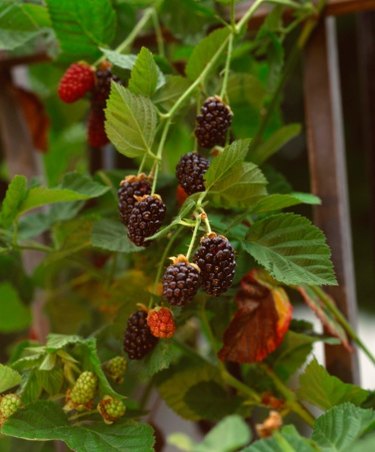
The culture for blackberries is similar to that of red raspberries, as both are considered brambles and are closely related species. A sunny garden spot with a deep, moist but well-drained soil promotes the best growth of blackberry canes. However, overly wet soil conditions and lack of air circulation between plants can lead to fungal infestations, especially anthracnose, powdery mildew and verticillium wilt. Use mulch to conserve soil moisture and eliminate the need for constant weeding across the berry patch.
Using Mulch Effectively
Video of the Day
When first planting new blackberry plants, don't be too eager to layer the soil among plants with mulch. As the young roots develop over the first summer, shallowly hoe no deeper than 1 inch and hand pull weeds so you don't harm the blackberry plants' establishment. Mulch near establishing plants can limit soil warmth and penetration of air into the soil profile. Once fall arrives, mulch the soil to prevent weeds and insulate the soil. Maintain the mulch as needed across the following years to maintain it 2 to 4 inches deep.
Video of the Day
Mulch Types
Do not use mulch sources that include wood chips or debris containing dead raspberry or blackberry twigs or remnants of potato, tomato or eggplant plants. These potentially contain pathogens that will affect the blackberries. Grass clippings, weed seed-free straw or hay, shredded tree leaves or small particles of tree bark work well. Allow clippings and hay to fully cure or dry before placing on the soil in the blackberry patch. Never introduce mold or fungi into the growing environment. Plastic sheeting works in cool summer areas, but not in hot climates.
Spreading Mulch
Apply mulch to a weed- and grass-free patch. Remove weeds or hoe before laying the mulch so seedlings cannot manage to still sprout upward through the layer of mulch. Keep mulch three inches away from the blackberry canes. Piles of mulch laying against the canes decreases air flow and slows water drainage and soil drying -- all conditions that promote fungal growth. In subsequent years when new mulch is added to maintain the layer, cut down suckering shoots of blackberries occurring between the plants or rows. Remove the cuttings; do not bury the blackberry cane and leaf debris under the new mulch layer.
Mulch for Winter Protection
In regions where the winter minimum temperatures dip below zero degrees Fahrenheit, extra mulch placed up and around the plant cane bases helps shield cold from reaching the blackberry plant crowns. The crown is the transitional area where the roots become above-ground canes with buds. Use a dry, coarse bark or straw mulch to lay on the plant bases, making the layer 6 to 12 inches thick. This mulch placed next to the winter-dormant canes and nestled around the plant crown must be promptly removed in early spring to allow sunlight to penetrate and good air circulation to return.
Best Practices
Contact your cooperative extension office for precise recommendations on mulch types, depths and current advisories for blackberry growers. Because of the vast array of soils, climates and disease issues across the United States, the extension office will be informed of latest university research and recommendations.